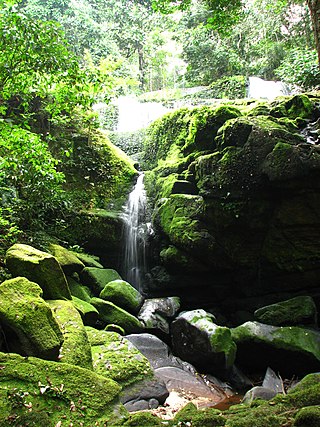
Ogooué-Ivindo Province is the northeasternmost of Gabon's nine provinces, though its Lopé Department is in the very center of the country. It gets its name from two rivers, the Ogooué and the Ivindo. This province, containing thousands of square kilometres of rainforest, is the largest and most sparsely populated and much less developed than the rest of the country. As of 2013 it had a population of 63,293 people. The principal town is Makokou.

Nyanga is the southernmost of Gabon's nine provinces. The provincial capital is Tchibanga, which had a total of 31294 inhabitants in 2013. Nyanga is the least populated province of the nine and the other least developed, besides Ogooué-Ivindo. It is bordered by Ogooué-Maritime in the northwest, Ngounié in the north, and the Congo to the south and east. The Atlantic Ocean—the lowest point in both Gabon and Nyanga Province—borders it in the west.

The Ogooué-Lolo Province is one of the nine provinces of Gabon, slightly southeast of central Gabon. The regional capital is Koulamoutou, a city of approximately 16,000 people. It is the ninth largest city in Gabon and the home of slightly more than one-third of the provincial population.

Haut-Ogooué is the southeasternmost of Gabon's nine provinces. It is named after the Ogooué River. It covers an area of 36,547 km2 (14,111 sq mi). The provincial capital is Franceville. One of its primary industries is mining, with manganese, gold and uranium being found in the region. The uranium-bearing mineral francevillite takes its name from the primary city. It is the historical home of three cultures, the Obamba, Ndzebi and Téké. Like many regions in Africa, more traditional uses of the land have given way to rural migration to the larger cities. In August 2006, its soccer club won the Gabon Independence Cup.

Moyen-Ogooué is one of Gabon's nine provinces. It covers an area of 18,535 km2 (7,156 sq mi). The provincial capital is Lambaréné. As of 2013, 69,287 people lived there.

Woleu-Ntem is the northernmost of Gabon's nine provinces. It covers an area of 38,465 km2 and named after Woleu and Ntem rivers that cross it. The provincial capital is Oyem, which had a total of 60,685 inhabitants in 2013.

Sebe-Brikolo is a department of Haut-Ogooué Province in eastern Gabon. The capital lies at Okondja. It had a population of 16,443 in 2013.

Lolo-Bouenguidi is a department of Ogooué-Lolo Province in central-eastern Gabon. The capital lies at Koulamoutou. It had a population of 30,643 in 2013.

Lombo-Bouenguidi is a department of Ogooué-Lolo Province in eastern Gabon. The capital lies at Pana. It had a population of 4,635 in 2013.

Haut-Komo is a department of Woleu-Ntem Province in northern Gabon. The capital lies at Médouneu. The department borders with Equatorial Guinea. It had a population of 3,403 in 2013.

Haut-Ntem is a department of Woleu-Ntem Province in northern Gabon. The capital is Minvoul. It had a population of 10,838 in 2013.

Estuaire is the most populous of Gabon's nine provinces. It covers an area of 20,740 km2. The provincial capital is Akanda, but the largest city is Libreville, Gabon's national capital. The province is named for the Gabon Estuary, which lies at the heart of the province.

As of 2011, Gabon contains 152 Cantons, 52 Communes, 29 Arrondissements, and 26 Districts. These are the third-level administrative units of Gabon and between them make up the units of the Departments of Gabon. Arrondissements tend to be units of major cities such as Libreville and communes are generally seated in the main cities and towns and incorporating the surrounding rural area. The cantons of Gabon are largely rural in nature with a small town or large village as the main centre.
The African nation of Gabon has had human inhabitants for perhaps 400,000 years. Bantu peoples settled here from the 11th century. The coastline first became known to Europeans through Portuguese and Dutch sailors. Colonised by the French in the 19th century, Gabon became independent in 1960.

Komo-Océan is a department of Estuaire Province in Gabon. The population was 553 in 2013.
Ogooué-Létili is a department of Haut-Ogooué Province in Gabon. It had a population of 2,791 in 2013.
Lékabi-Léwolo is a department of Haut-Ogooué Province in Gabon. It had a population of 4,914 in 2013.
Bayi-Brikolo is a department of Haut-Ogooué Province in Gabon. It had a population of 1,998 in 2013.

Mongo is a department of Nyanga Province in Gabon. Its chief town is the city of Moulengui-Binza. It had a population of 2,602 in 2013.
Offoué-Onoye is a department of Ogooué-Lolo Province in Gabon. It had a population of 2,743 in 2013.




















